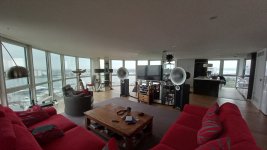Ha! Along with subs, DSP room correction is something I work hard to avoid the need for.
My current amp has Dirac Live built in and previous ones have had RoomPerfect (Lyngdorf) and MARS (Micromega). In all cases, although the bass may be slightly flatter when viewed on a frequency plot, the problem has always been that top end sparkle is diminished. Now the fact that these DSPs only ADJUST the bass (Dirac is only sub 500Hz), how can this be? Answer (my theory, yet to be demolished) is related to the letters S and P in DSP - Signal and Processor. The less processing a signal is subjected to, the better it survives on its journey towards the speakers. With these full-range amps, the entire signal is subjected to the processor, even the top end. That's why I avoid DSP in full-range amps. Also the end result, though audibly “different”, never sounds "better". Best left to the AV guys or those with multiple speakers where manual setting up becomes increasingly a specialist job.
With my speakers (Avantgarde Duo XDs) and ones I tried a while back (Martin Logan 13As) their active bass amps have DSP built in, leaving the rest of the un-DSP'd signal to reach the speakers unmolested. Only the bass is processed. As I mentioned earlier, I've not really tried to apply this XD filter. It's not as simple as Dirac's auto-set option where taking microphone readings and clicking "store" get the correction filter squirted directly into the amp – job done. XD is a completely manual system where the starting base is a straight line, you take independent microphone readings with REW or similar and adjust the straight line to compensate for the measured inaccuracies. Peter

